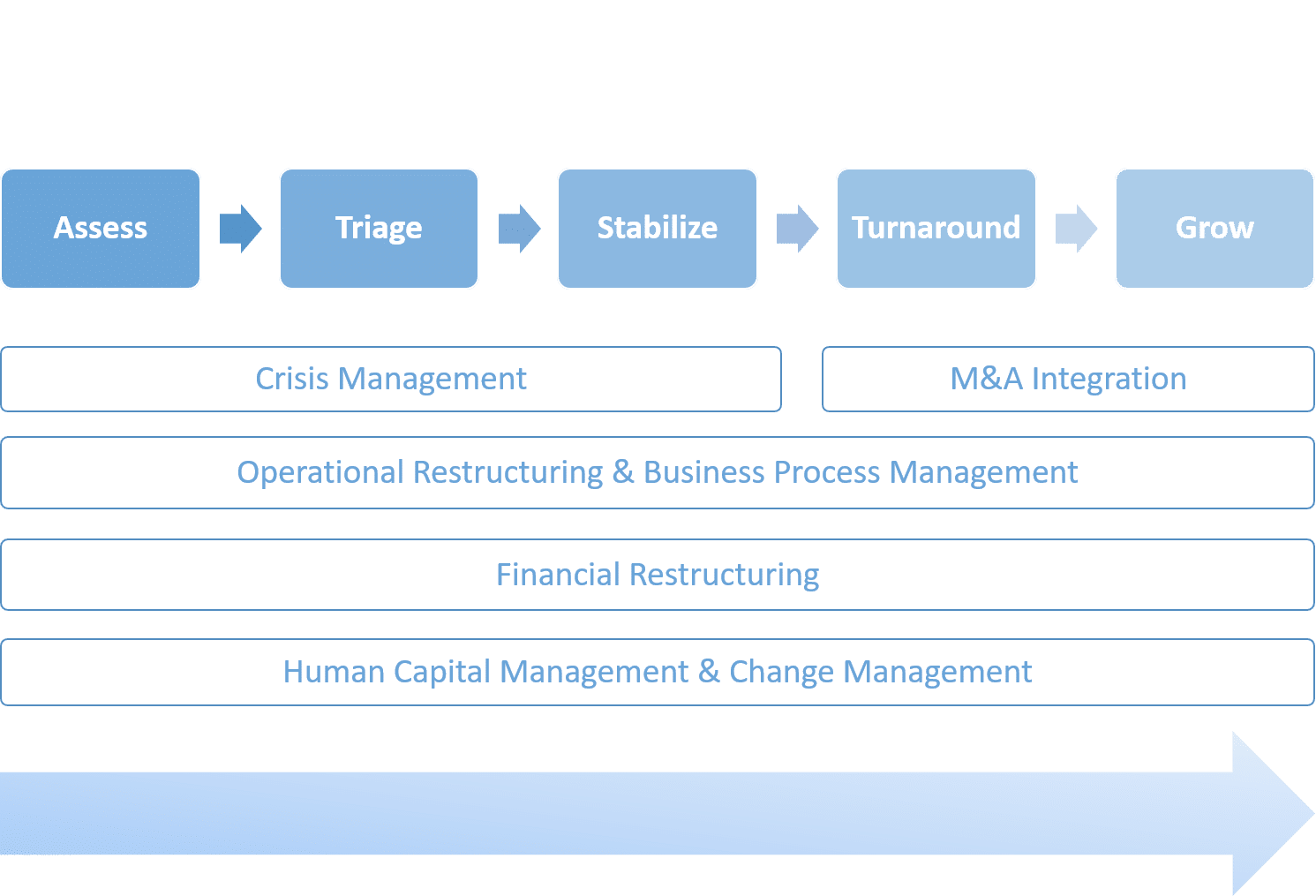If your business is struggling, then your number one goal likely is to get to a point where your business is stabilized. As soon as you reach this point, you can start thinking about turnaround and growth opportunities.
So, where do you start? With fact finding. Once you conduct fact-finding assessments of the situation, you can prepare a plan to fix the problems.
Then, you must relentlessly implement the planned courses of action by funding the process and building a team to carry it out. Finally, you must monitor your progress and make changes where necessary.
Read on to learn about the five phases of a business turnaround in more detail.
Diagnosing the Situation
Our turnaround management consulting services include discoveries, financial restructuring, cost reduction and revenue improvement opportunities.
The 5 Phases of Business Turnaround
Below we’ve outlined the key phases of a business turnaround and restructure. By following this structure, you will preserve and enhance value, optimize financial resources and develop options for corporate recovery and renewal.

As seen in the chart above, there are five stages in the turnaround process: assess, triage, stabilize, turnaround and grow. The process is designed to first assess and get a handle on the root cause and impact of the crisis.
Then, a plan is put in place to quickly triage and stabilize the company. During these phases, it’s important to position the company for growth, so that growth can begin as soon as turnaround is reached.
Some of the aspects within these phases are outlined in more detail below:
1. Crisis Management
This involves identifying the key areas of crisis, defining business needs and gathering information about why those business needs are not being met. Business crisis consulting helps define the objectives of the operational restructuring program. During this time, it’s important to look for strategic and operational gaps as well as issues with the company’s culture that need to be addressed to support the new business model.
2. Financial Restructuring
This entails managing cash flow by forecasting, restructuring obligations and tightly managing finances. The goal is to restructure the entity to survive and determine what you will need in order to do so. Once you’ve determined your needs, it’s important to communicate the situation with investors and the board of directors to help with funding.
3. Business Process Improvement
This is where you map out all processes to consolidate systems and duties, and to remove waste and redundancies. During this time, many companies undertake business process reengineering.
4. Operational Restructuring
This involves setting KPIs and evaluating the organization to meet those KPIs. It also involves determining how to continue operations while satisfying short-term debt and operational expenses. Unfortunately, operational restructure can be the most painful aspect of a business turnaround because it has a significant impact on the organization and business process. This is where organizational change management (mentioned below) becomes essential.
5. Human Capital Management
This entails reworking compensation models by looking at options to reduce payroll, calibrate compensations and rework incentives. This is a great time to trim the fat, get rid of toxic employees and replace all senior executive positions with a turnaround management consulting team.
6. Organizational Change Management
This is where you create a communications plan and renew relationships with customers and vendors. You should also focus on retaining talented employees since this will enable the turnaround and rebuild the culture. Turnaround change management is important because none of the previous work is worth anything if employees don’t understand what they are accountable for.
7. Turnaround Analysis
This involves determining the severity of the situation and whether it can be turned around. The analysis culminates in a preliminary action plan stating what is wrong, how to fix the situation, key strategies to turn the entity in a positive direction and a cash flow forecast to understand cash usage.
8. M&A Integration
Merger and acquisition integration entails creating a framework for pre-merger analysis and post-merger integration planning and execution – all within the first 100 days.

Business Turnaround Success Factors
A key success factor for business turnarounds is flexibility. In unstable environments, the agility to respond to changing conditions is necessary, so turnaround plans need to be adaptable.
Another success factor is accountability. Business units need to be held accountable but also be given the autonomy and trust to achieve end-goals. This requires reliable metrics and governance allowing management to remain informed and make any tough decisions early. One decision might be to reduce waste and reassign resources to the most important activities.
Positioning Companies to Attract a Buyer
For some companies, turnaround means looking for a buyer. If you’re in this boat, it’s important to understand what investors and buyers are looking for:
- Businesses that create value and have consistency period to period
- High probability of future cash flows, and a history of performance and improvement (or the promise of cash)
- Market-oriented management team and a focus on producing revenue
- Ability to sell, compete and grow as well as the ability to develop, produce and distribute products (track record or demonstrated changes in the right direction)
- Fair entry valuation and realistic return potential
- Exit options and the likelihood of realizing high ROI at the time of their resale
FAQs About Business Turnarounds
What is a turnaround consultant?
A turnaround consultant analyzes your financial statements to identify areas of concern. They may cut overhead costs, streamline operations and negotiate with your suppliers, debt holders and shareholders in order to restructure your company. Restructuring moves a company from poor financial performance to breakeven and eventually towards a financially healthy company. A turnaround consultant also may benchmark your company’s performance and apply industry best practices so the business can perform to the KPIs that make you successful in your industry.
What is a turnaround firm?
A turnaround firm brings a team of turnaround consultants and deploys them quickly to the different areas of the business to quickly identify root causes of distress. A turnaround firm focuses on preserving cash and keeping costs down for the company so it may go through financial turnaround and be able to prosper. Turnaround firms also will take a minority equity stake and keep their costs to a minimum to create goal alignment with the business owners. Liquidity management is the lifeline of the organization so the focus of a turnaround firm is extending the company’s runway to facilitate a rapid turnaround.
What does a turnaround specialist do?
A turnaround specialist is someone with a broad skillset and track record of successfully turning around companies. They may act as an interim CEO or executive on a short-term basis in order to effect the necessary changes to conserve cash and quickly bring stability to the company. The duties of a turnaround specialist vary from company to company but having a well-rounded and experienced individual is key to be able to identify areas of concern and improve your cash position. A turnaround specialist should methodically plan on cash-flow optimization and conflict resolution, so they can leverage limited resources in order to create the value. In addition, a turnaround specialist should restore the trust between equity investors, management and venture lenders to ensure that everyone is working together toward renewed cash flow.
What is turnaround and restructuring?
Restructuring often refers to financial and operational restructuring. In a financial restructure, cash is king. The focus is on managing cash flow by forecasting, restructuring obligations and tightly managing finances. The goals is to restructure the entity to survive and determine what you will need to turnaround. Operational restructure, on the other hand, is focused on determining how to continue operations while satisfying short-term debt and operational expenses. Essentially, in order to turn around a company from poor financial performance to strong financial performance, it will have to undergo a financial and operational restructure.
What is a turnaround strategy?
A turnaround strategy is focused on the efficiency and effectiveness of the core business. The strategy should take a balanced approach between short-term benefits and long-term strategic goals. The short-term strategy is always to stop the cash bleeding with an eye on having enough resources to pull the company out of survival mode and into growth mode.
What are the phases of a turnaround?
There are five stages in the turnaround process: assess, triage, stabilize, turnaround and grow. You can find more detail at the beginning of this post.
Do You Know How to Turn a Company Around?
While you may understand the concepts involved in turning around a business, it’s always helpful to have a business turnaround consultant with an outside perspective. We can provide this unbiased viewpoint and help you make tough decisions during crisis situations.
Business turnaround requires a focus on both short-term benefits and long-term strategic goals. We can help you achieve short-term benefits to attract an acquisition partner, or we can take you from a turnaround to a transformation that yields revenue growth.
If you are an organization, lender or PE firm interested in business turnaround, request a free consultation below to learn about our financial restructuring services and operations management consulting.














